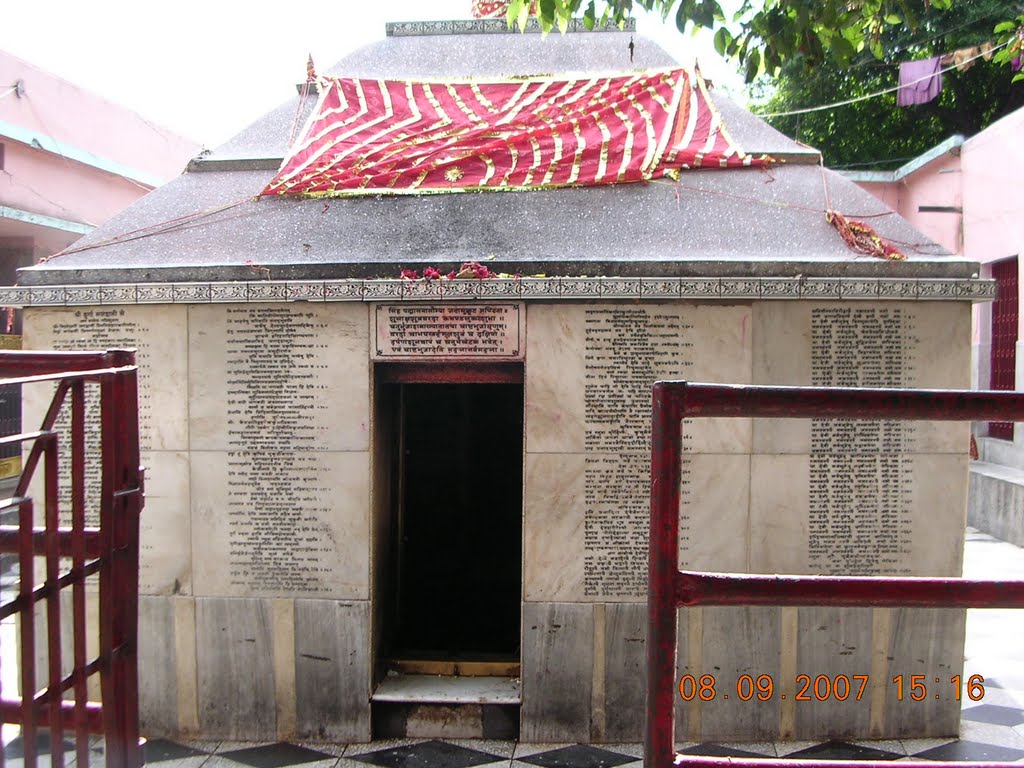The Mangalagauri temple in Gaya has been mentioned in Padma Purana, Vayu Purana and Agni Purana and in other scriptures and tantric works. The present temple dates back to 1459 AD. The shrine is dedicated to Shakti or the mother Goddess in the predominantly Vaishnavite pilgrimage centre of Gaya.
Shrine’s History
Sati killed herself by self-immolation after her father insulted her husband, Lord Shiva. arrived a little too late upon hearing the news, after his wifes body was already burning. He took the body from the fire and started his dance of cosmic destruction. The other gods wanted to stop his dance and they requested Lord Vishnu to convince him. Lord Vishnu with the help of his Sudarshan chakra cut Satis body into 51 pieces and made Siva stop the dance. It is said in Gaya Satis breast fell, and hence here Sati is worshipped in the form of a breast symbol, a symbol of nourishment.
Legends Associated with This Shrine
In olden times there lived a sage by name Dahabiya who once went to GayaKshetraand performed sacred rites (Pinda Pradhana) to his forefathers with utmost devotion and after that started doing penance at this place. One day while he was doing penance a cosmic plane appeared before him and a divine person got down from it and asked him why was he doing this penance? Then the sage Dhaibhyainreply asked the cosmic person to disclose his details. The cosmic person told the sage that he was the Brahma Manasa Putra and brother of Rudra called Sanathkumara who lives in one of the ur diva lokas(Jano loka).
He further said O Sage you have performed Pinda Pradhana at Gaya Kshetra with the result the entire Brahma Vamsa got the benefit and I have come here to bless you and show my affinity towards you.? On further questioning by sage as to how his actions had benefited, Sanathkumara started narrating an incident related to GayaMahatmya .In olden times there lived a king called Vishala who was a highly spiritual and religious minded person ruling his kingdom in Dharma Marga. His only shortfall was the lack of children. On being advised by his purohits the king went to GayaKshetraand performed sacred rites to his forefathers (Pinda Dana, Thila Tharpana). While doing so there appeared three persons in the sky who were in three different colours (white, red and black) and they started glaring at the King with love and affection.
On being asked the white coloured person started telling that,he was his father, the red coloured person was his grand father who had committed lot of sins while he was alive and the black coloured person was his great grand father who also had committed similar worst sins during his life time. Due to this, they were suffering in the hell. Because of good deeds were done, I have acquired the heavenly status.? Now, due to your visit to the Gaya Kshetra and performing sacred rites (Pinda daana) your grand father and great grand father have been released from the hell and have joined me in the heaven.
Thus you are responsible for the liberation of your forefathers from the hell by performing Pinda Pradhana andTharpana at Gaya Kshetra. Now we are happily going to Pitru Loka and have come here to see you and bless you.After this incident, the king Vishala returned to his kingdom and soon was blessed with a son. Hence, this place (Gaya) has acquired a lot of significance and Lord MahaVishnu holding mace in his hand is residing here. Thus spoke Sanathkumara to thesage Dahabiya and disappeared.
Architectural Relevance of This Shrine
The temple is facing east and is built on top of the Mangalagauri hill. A flight of steps and a motorable road lead to the temple. The sanctum houses the symbol of the Goddess and it also has some finely carved ancient relief sculptures. A small hall or mandap stands in front of the temple. The courtyard also houses a fire pit for the home. There are also two minor shrines dedicated to Shiva and images of Mahishasura MardiniGaya is one of the most famous spiritual destinations in India. Gaya is located in Bihar and stands on the bank of Falgu River. Gaya in India is held holy and pious by both Hindu and Buddhists. The narrow by lanes with age-old buildings, beautiful natural surroundings with rocky hills on the three sides and river flowing by the city on the western side makes the city look beautiful and relates the spiritual atmosphere of the place.
Shrine’s Map Location and How to Go There
By Road
Regular direct bus services are available from Gaya to Patna, Nalanda, Rajgir, Varanasi,Ranchi,Tata(Jamshedpur),Kolkata,Dhanbad. Bihar State Tourism Development Corporation and Bihar State Road Transport Corporation run buses to Patna, Ranchi, Jamshedpur and other major cities.
By Rail
The nearest railway station is Gaya Jn. (5 km).
By Air
The city has the only operating international airport in Bihar and Jharkhand. It has domestic operations for Kolkata, New Delhi and Varanasi, while international flights are for Bangkok, Yangon and Colombo.
